
The Lalo Loor reserve is teeming with plant and animal diversity, and presents a unique mix of species characteristic of the very wet Chocó forests to the north and the very dry Tumbesian scrublands to the south. We’re located right in the middle of this gradient, and enjoy the best of both worlds (literally, both hemispheres)!
Rufous-headed Chachalacas, named for the raucous cries they deliver as a chorus, are commonly seen (and heard!) in the reserve
There is excellent birding along the entrance road, the self-guided nature trail, and along the stream, with a chance of seeing several rare species including the Red-Masked Parakeet, Pale-browed Tinamou, and the Little Woodstar hummingbird. The endangered Gray-backed Hawk can often be seen circling overhead. Other species of note that are commonly observed in the reserve include Guayaquil Woodpecker, Pacific Royal-Flycatcher, and the Rufous-headed Chachalaca. Biological inventories continue to add to our species list. Please submit any new species you may have observed at the reserve.
Ecuadorian Mantled Howler monkeys are the highlight of any visit to the Lalo Loor Dry Forest, where they frequently swing through the treetops and fill the air with their roars calls
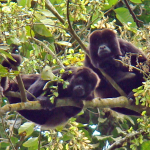 The Lalo Loor Dry Forest Reserve provides a refuge for populations of many mammals characteristic of the region. Troops of Mantled Howler monkeys (Alouatta palliata) are commonly encountered, as they feast on the reserve’s many fig trees. The occidental variety of Ecuadorian White-fronted Capuchin monkeys (Cebus albifrons aequatorialis) are present in the forest, where they actively leap through the canopy in search of fruits and insects. Peccary, jaguarundi, tamandua (anteater) and ocelot have been seen within the reserve. Please add to our growing species list if you see anything new!
The Lalo Loor Dry Forest Reserve provides a refuge for populations of many mammals characteristic of the region. Troops of Mantled Howler monkeys (Alouatta palliata) are commonly encountered, as they feast on the reserve’s many fig trees. The occidental variety of Ecuadorian White-fronted Capuchin monkeys (Cebus albifrons aequatorialis) are present in the forest, where they actively leap through the canopy in search of fruits and insects. Peccary, jaguarundi, tamandua (anteater) and ocelot have been seen within the reserve. Please add to our growing species list if you see anything new!
The long dry season at Lalo Loor can be challenging for frogs and other amphibians, but when the rains finally arrive, the forest is literally hopping with them
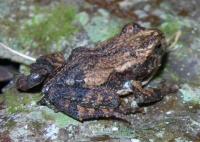 Although the reserve is dominated by dry, deciduous forest, it harbors an astonishing variety of amphibians. This diversity is due in part to our proximity to the wet and hyper-diverse Chocó forests of Ecuador’s northwest, and in part to the year-round stream that flows through the heart of the reserve. The humid forest habitat clustered around the El Tillo stream-bed is home to many frogs and toads, most common among them being the little Colostethus machalilla. Even when the long dry season has reduced the stream to a trickle, one can still find frogs along its banks; when the rains return in January these frogs anxiously begin seeking mates, calling furiously both night and day. Researchers and Ceiba staff continue to add to the reserve’s amphibian and reptile species list. If you are planning to visit the reserve, you can download our color identification guide, prepared by Carl Hutter.
Although the reserve is dominated by dry, deciduous forest, it harbors an astonishing variety of amphibians. This diversity is due in part to our proximity to the wet and hyper-diverse Chocó forests of Ecuador’s northwest, and in part to the year-round stream that flows through the heart of the reserve. The humid forest habitat clustered around the El Tillo stream-bed is home to many frogs and toads, most common among them being the little Colostethus machalilla. Even when the long dry season has reduced the stream to a trickle, one can still find frogs along its banks; when the rains return in January these frogs anxiously begin seeking mates, calling furiously both night and day. Researchers and Ceiba staff continue to add to the reserve’s amphibian and reptile species list. If you are planning to visit the reserve, you can download our color identification guide, prepared by Carl Hutter.
Lizards, turtles, snakes, and iguanas abound in the dry forest, where the brown leaf litter provides a perfect background for camouflaged reptiles
Dry forests, with their many rainless months, are much more easily tolerated by reptiles, whose hard-shelled eggs and dry skin confers an advantage over their amphibian cousins. The Lalo Loor Reserve is rich in lizards, including several geckos, and has a diverse snake community. One should be cautious approaching any snake: poisonous snakes are found in the reserve, primarily the Fer-de-Lance (Bothrops atrox); however, these snakes generally are passive and lethargic, and do not pose a risk to visitors if left alone. Research conducted in the reserve for the past five years by Arizona State’s Paul Hamilton has added considerably to the reserve’s growing species list.
Despite the strong seasonality of the reserve, there's always something in flower, from trees to shrubs to understory herbs, and even orchids!
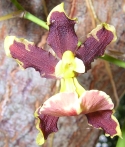 Although the abundance of orchids in deciduous forests is lower than in wetter habitats, our observations in a limited area in the Lalo Loor Dry Forest Reserve indicate high species diversity and suggest several areas for further study. We found 27 species of orchids in at least 23 genera. Dimeranda rimbachii is the most abundant epiphytic orchid at BSLL, growing on virtually every large canopy tree, within the elevational range we sampled. Other abundant and widespread species include Notylia sp., Catasetum expansum, Oncidium hyphaematicum, and Lockhartia serra. Other species were found only in low numbers or near the upper extent of our sample, such as Psychopsis kramerianum and Huntleya fasciata. Cattleya maxima and an Epidendrum species were found growing at Punta Prieta, a private property about 10 km to the south, but are likely also to occur at BSLL. As surveys become more exhaustive, we hope to clarify these distribution patterns further. We also expect that a sampling of the higher elevations will yield additional species, such as the Lycaste and Sobralia species previously found during a survey by the National Herbarium in a forest nearby. If you are interested, please view our current orchid list.
Although the abundance of orchids in deciduous forests is lower than in wetter habitats, our observations in a limited area in the Lalo Loor Dry Forest Reserve indicate high species diversity and suggest several areas for further study. We found 27 species of orchids in at least 23 genera. Dimeranda rimbachii is the most abundant epiphytic orchid at BSLL, growing on virtually every large canopy tree, within the elevational range we sampled. Other abundant and widespread species include Notylia sp., Catasetum expansum, Oncidium hyphaematicum, and Lockhartia serra. Other species were found only in low numbers or near the upper extent of our sample, such as Psychopsis kramerianum and Huntleya fasciata. Cattleya maxima and an Epidendrum species were found growing at Punta Prieta, a private property about 10 km to the south, but are likely also to occur at BSLL. As surveys become more exhaustive, we hope to clarify these distribution patterns further. We also expect that a sampling of the higher elevations will yield additional species, such as the Lycaste and Sobralia species previously found during a survey by the National Herbarium in a forest nearby. If you are interested, please view our current orchid list.
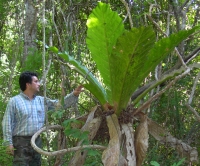 In addition to orchids, the coastal dry forest is rich in other epiphytes (plants that live on trees) such as bromeliads and aroids (Taro relatives). Epiphytes use a variety of adaptations to survive the hot dry season, including using root or stem tissue for storage. Perhaps the most famous example of this approach is the cactus, which stores moisture in its spiny trunk (and there are epiphytic cacti!), but other plants do the same: orchids use their pseudobulbs (swollen upper roots), while bromeliads and aroids collect leaf litter and moisture around their leaf bases. These arboreal plants often are homes to many kinds of animals, such as frogs, which often lay their eggs in bromeliad “tanks” when other water is not available.
In addition to orchids, the coastal dry forest is rich in other epiphytes (plants that live on trees) such as bromeliads and aroids (Taro relatives). Epiphytes use a variety of adaptations to survive the hot dry season, including using root or stem tissue for storage. Perhaps the most famous example of this approach is the cactus, which stores moisture in its spiny trunk (and there are epiphytic cacti!), but other plants do the same: orchids use their pseudobulbs (swollen upper roots), while bromeliads and aroids collect leaf litter and moisture around their leaf bases. These arboreal plants often are homes to many kinds of animals, such as frogs, which often lay their eggs in bromeliad “tanks” when other water is not available.
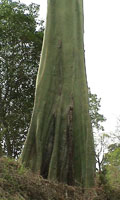 Studies of the trees in the Lalo Loor reserve, by the National Herbarium in Quito, have turned up some very surprising discoveries. Among these is Exothea paniculata (Family: Sapindaceae), which although not uncommon within the reserve, has never been discovered elsewhere in Ecuador! In fact, the nearest record for this species is over 1000 km away. Several other species either rare, or completely new to science, also have been found in the reserve. The National Herbarium has established two permanent 1-ha plots within the reserve, already exhaustively sampled, which will be monitored year-round to track plant phenology: the pattern of fruiting and flowering throughout the year.
Studies of the trees in the Lalo Loor reserve, by the National Herbarium in Quito, have turned up some very surprising discoveries. Among these is Exothea paniculata (Family: Sapindaceae), which although not uncommon within the reserve, has never been discovered elsewhere in Ecuador! In fact, the nearest record for this species is over 1000 km away. Several other species either rare, or completely new to science, also have been found in the reserve. The National Herbarium has established two permanent 1-ha plots within the reserve, already exhaustively sampled, which will be monitored year-round to track plant phenology: the pattern of fruiting and flowering throughout the year.
Common to the region, particularly the southern and drier portion of the Manabí province is the striking green giant Ceiba trichastandra. Spiny when young, to prevent herbivores from damaging the trunk, this tree has green bark that is photosynthetically-active even when the tree sheds its leaves in the dry season. Because of the height and enormous weight of these trees, they develop buttresses near their bases that spread out and help support their immense mass.
Also abundant in the reserve are a diverse assortment of palms. These include spiny Bactris palms (used elsewhere as indigenous blowguns), towering Attalea palms (whose fruits are sought by parrots and macaws), and the vegetable ivory palm known as Tagua (nuts from which are fashioned into all manner of artisan crafts).